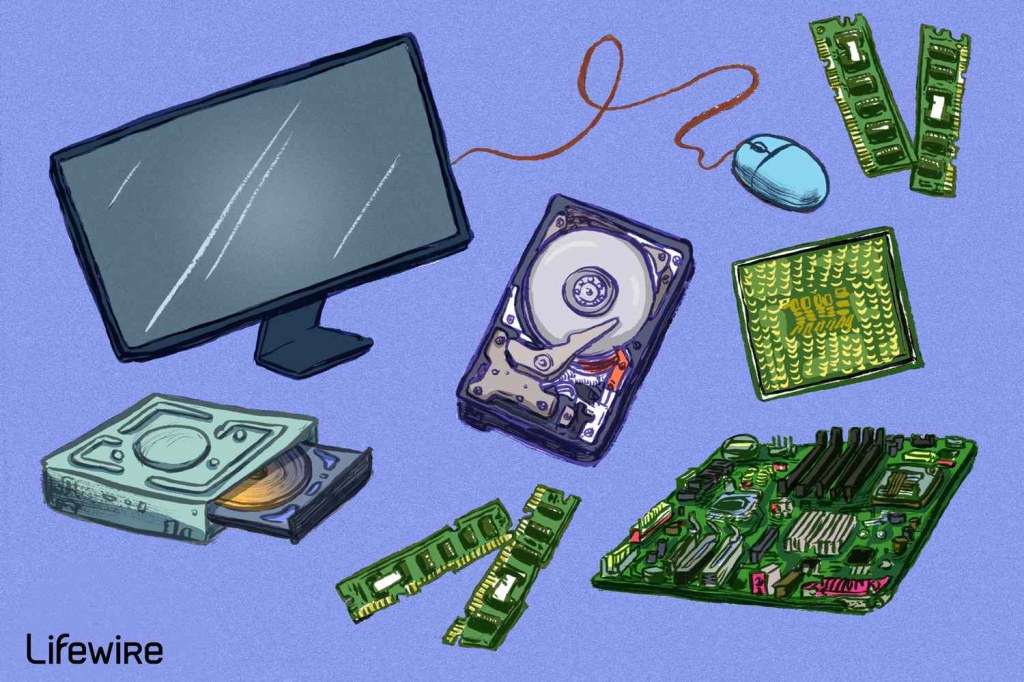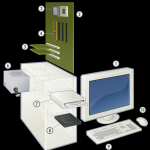Unlock The Power Of Computer Hardware Information: Your Ultimate Guide To Maximize Performance
Computer Hardware Information
Hello Readers, welcome to this informative article on computer hardware information. In today’s digital age, understanding computer hardware is essential for anyone who uses a computer. Whether you are a tech enthusiast or simply a curious individual, this article aims to provide you with valuable insights into the world of computer hardware. So, let’s dive in and explore the fascinating realm of computer hardware!
1 Picture Gallery: Unlock The Power Of Computer Hardware Information: Your Ultimate Guide To Maximize Performance

Introduction
Computer hardware refers to the physical components of a computer system that can be seen and touched. It includes devices such as the central processing unit (CPU), motherboard, random access memory (RAM), hard drive, graphics card, and many more. These components work together to enable the functioning of a computer and its software.

Image Source: lifewire.com
In this article, we will delve into various aspects of computer hardware, including its history, types, functions, and advancements. By the end of this article, you will have a comprehensive understanding of computer hardware and its significance in today’s technological landscape.
So, without further ado, let’s explore the world of computer hardware and unlock its mysteries!
What is Computer Hardware?
Computer hardware comprises physical components that make up a computer system. These components serve as the building blocks of a computer and are responsible for executing tasks and processing data. They include both internal components, such as the motherboard and CPU, as well as external devices like keyboards, mice, and monitors.
Understanding computer hardware is crucial as it allows users to make informed decisions when purchasing, upgrading, or troubleshooting their computer systems. By having knowledge of computer hardware, users can ensure optimal performance, compatibility, and efficiency of their devices.
Let’s take a closer look at the main components of computer hardware:
1. Central Processing Unit (CPU)
The CPU, often referred to as the brain of the computer, is responsible for executing instructions and performing calculations. It is the most crucial component of a computer system and determines its overall performance.
The CPU consists of two main parts: the control unit, which manages data flow and instructions, and the arithmetic logic unit, which performs calculations and logical operations. The speed and efficiency of a CPU are measured in gigahertz (GHz) and the number of cores it has.
2. Motherboard
The motherboard serves as the main circuit board of a computer and allows all the components to communicate with each other. It provides the necessary connections and interfaces for components such as the CPU, RAM, and storage devices.
The motherboard acts as a central hub, ensuring the smooth operation of all hardware components. It also houses the BIOS (Basic Input/Output System), which initializes the computer and manages its settings.
3. Random Access Memory (RAM)
RAM is a type of temporary storage that allows the computer to access data quickly. It stores the data and instructions that the CPU needs to perform tasks. The more RAM a computer has, the smoother and faster it can handle multiple tasks simultaneously.
RAM is volatile memory, meaning it loses its data when the computer is powered off. Therefore, it is vital to save important files and documents on a permanent storage device like a hard drive.
4. Storage Devices
Storage devices are used to store data, including the operating system, applications, and files. The two main types of storage devices are hard disk drives (HDDs) and solid-state drives (SSDs).
HDDs are traditional mechanical drives that use spinning disks to store and retrieve data. They offer larger storage capacities but are slower compared to SSDs. On the other hand, SSDs use flash memory and have no moving parts, resulting in faster access times and improved durability.
5. Graphics Processing Unit (GPU)
The GPU is responsible for rendering images, videos, and animations on the computer screen. It offloads the graphical processing tasks from the CPU, allowing for smoother and more realistic visuals.
GPUs are especially crucial for gaming and multimedia applications that require high-resolution graphics and fast rendering speeds. They come in dedicated graphics cards or integrated into the CPU.
6. Input and Output Devices
Input devices, such as keyboards and mice, allow users to enter data and commands into the computer. Output devices, such as monitors and printers, display or produce the results of computer processing.
These devices enable users to interact with the computer and receive information in a user-friendly format. They play a vital role in facilitating communication between humans and machines.
Who Uses Computer Hardware?
Computer hardware is used by a wide range of individuals and organizations, including:
1. Individuals:
Computer hardware is essential for personal use, whether it’s for work, entertainment, or communication. Individuals rely on computer hardware for various tasks, such as browsing the internet, creating documents, playing games, and editing multimedia.
Having knowledge of computer hardware allows individuals to make informed decisions when purchasing a new computer or upgrading their existing setup. It also enables them to troubleshoot and fix hardware-related issues.
2. Businesses:
Businesses of all sizes rely on computer hardware for their daily operations. From simple tasks like word processing to complex processes like data analysis and server management, computer hardware plays a crucial role.
Businesses utilize computer hardware to improve productivity, efficiency, and communication. They invest in powerful servers, networking equipment, and storage devices to support their operations and store critical data.
3. Educational Institutions:
Education systems heavily rely on computer hardware to facilitate learning and provide students with access to digital resources. Schools, colleges, and universities use computer hardware for tasks such as delivering online lectures, conducting research, and managing administrative processes.
Computer labs equipped with hardware components allow students to gain practical experience and develop essential skills in the field of technology.
4. Scientific and Research Institutions:
Scientific and research institutions utilize high-performance computer hardware for data analysis, simulations, and modeling. Supercomputers and specialized hardware components enable researchers to tackle complex problems and make groundbreaking discoveries.
These institutions require advanced computer hardware to handle large datasets, perform complex calculations, and visualize scientific data.
5. Government Organizations:
Government organizations rely on computer hardware for administrative tasks, data management, and security purposes. They utilize computer hardware to process large volumes of data, maintain records, and ensure efficient communication.
Government agencies also employ specialized hardware for defense, law enforcement, and intelligence gathering.
When Was Computer Hardware Invented?
The history of computer hardware dates back to the early 19th century when the concept of programmable machines began to emerge. However, it wasn’t until the mid-20th century that significant advancements in computer hardware took place.
In 1944, the Harvard Mark I, an electromechanical computer, was completed. It was one of the first programmable computers and paved the way for future developments. The invention of transistors in the late 1940s and integrated circuits in the late 1950s revolutionized computer hardware by making it smaller, faster, and more reliable.
The introduction of microprocessors in the early 1970s marked a significant milestone in computer hardware history. Microprocessors, such as the Intel 4004, allowed for the integration of multiple components onto a single chip, leading to the development of personal computers.
Since then, computer hardware has continued to evolve rapidly, with advancements in processing power, storage capacity, and connectivity. The introduction of technologies like virtual reality, artificial intelligence, and quantum computing has further pushed the boundaries of what computer hardware can achieve.
Where Can You Find Computer Hardware?
Computer hardware can be found in various places, including:
1. Retail Stores:
Retail stores specializing in electronics and computer products offer a wide range of computer hardware components. Customers can visit these stores and purchase hardware components individually or as part of pre-built computer systems.
Knowledgeable staff in these stores can provide guidance and recommendations based on customers’ requirements and preferences.
2. Online Marketplaces:
Online marketplaces, such as Amazon, Newegg, and Best Buy, provide a convenient platform for purchasing computer hardware. Customers can browse through a vast selection of products, read reviews, compare prices, and make informed decisions.
Online marketplaces often offer competitive prices and deliver products directly to the customer’s doorstep, saving time and effort.
3. Computer Repair Shops:
Computer repair shops not only provide repair and maintenance services but also sell computer hardware components. Customers can visit these shops to purchase replacement parts or upgrade their existing systems.
Computer repair technicians can also provide valuable insights and recommendations based on their expertise and experience.
4. Manufacturer Websites:
Many computer hardware manufacturers have their own websites where customers can explore and purchase their products. These websites often provide detailed specifications, compatibility information, and support resources.
Visiting manufacturer websites allows customers to have direct access to the latest product offerings and special deals.
5. Online Forums and Communities:
Online forums and communities dedicated to computer hardware are valuable resources for finding information and recommendations. Users can seek advice from experienced individuals, share their experiences, and discuss the latest trends in computer hardware.
Participating in these forums allows users to stay up to date with the latest developments and make informed decisions when purchasing computer hardware.
Why is Computer Hardware Important?
Computer hardware is of paramount importance for several reasons:
1. Performance and Efficiency:
Computer hardware significantly affects the performance and efficiency of a computer system. Powerful hardware components, such as high-speed CPUs and ample RAM, allow for faster data processing and multitasking capabilities.
By investing in quality computer hardware, users can experience smoother and more responsive computing experiences, whether it’s for gaming, video editing, or professional tasks.
2. Compatibility and Upgradability:
Understanding computer hardware is crucial for ensuring compatibility between different components and peripherals. Users need to be aware of hardware specifications, such as socket types, form factors, and interfaces, to avoid compatibility issues.
Furthermore, knowledge of computer hardware enables users to upgrade their systems effectively. By identifying bottlenecks and outdated components, users can make targeted upgrades that improve overall performance and extend the lifespan of their computers.
3. Troubleshooting and Maintenance:
Inevitably, computer hardware may encounter issues over time. Having knowledge of computer hardware allows users to troubleshoot and diagnose problems effectively.
By understanding the functions and connections of different hardware components, users can identify faulty parts, replace them if necessary, and resolve common hardware-related issues.
4. Personalization and Customization:
Computer hardware provides users with the flexibility to personalize and customize their systems according to their needs and preferences. Users can choose specific components that cater to their requirements, such as high-performance CPUs for gaming or professional-grade graphics cards for design work.
Customizing computer hardware allows users to optimize their systems for specific tasks and extract the maximum potential from their devices.
5. Innovation and Advancements:
Computer hardware fuels innovation and advancements in various fields, including technology, science, and entertainment. Advancements in hardware components enable the development of more powerful computers, advanced artificial intelligence algorithms, immersive virtual reality experiences, and more.
As computer hardware continues to evolve, new possibilities and opportunities arise, revolutionizing industries and pushing the boundaries of what technology can achieve.
How Does Computer Hardware Work?
Computer hardware components work together harmoniously to execute tasks and process data. Here is a brief overview of how computer hardware works:
1. Input:
Input devices, such as keyboards and mice, allow users to enter commands and data into the computer. When a user presses a key on the keyboard, for example, the input device sends the corresponding signal to the computer.
2. Processing:
The CPU receives the input signals and performs the necessary calculations and operations. It executes instructions and manipulates data according to the program being run.
The CPU retrieves instructions and data from the RAM and performs arithmetic, logical, and control operations. It also coordinates the flow of data between different hardware components.
3. Memory:
RAM plays a crucial role in providing the CPU with temporary storage for instructions and data. When the CPU needs to perform a task, it retrieves the necessary instructions and data from the RAM and stores the intermediate results back into the RAM.
RAM allows for quick access to data, improving the overall performance of the computer. However, it is volatile memory, meaning it loses its data when the computer is powered off.
4. Storage:
Storage devices, such as hard drives and SSDs, are responsible for storing data persistently. They provide long-term storage for the operating system, applications, files, and other data.
When data needs to be stored or retrieved, the storage devices read from or write to the magnetic or flash memory cells, respectively. The data is stored in a binary format, with each bit represented as a magnetized or non-magnetized area on the disk or a charged or uncharged cell in the flash memory.
5. Output:
Output devices, such as monitors and printers, display or produce the results of the computer’s processing. When the CPU
This post topic: Computer Hardware

